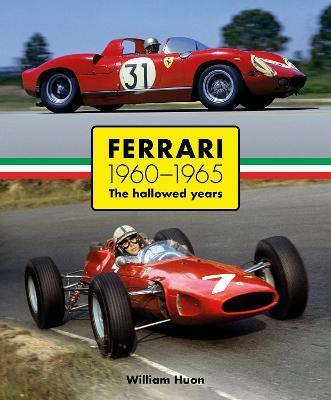Ferrari: 1960-1965 the Hallowed Years

Ferrari: 1960-1965 the Hallowed Years
The subject of this book is Ferrari's racing history from 1960 to 1965, a period that was one of the most successful in the marque's history so far. In this era, which began with completion of the transition from front-engined to rear-engined configuration, Scuderia Ferrari won just about everything with a variety of iconic machinery that included the 'shark-nose' 156 and the fabled 250 GTO. Driving Formula 1 Ferraris, Phil Hill and John Surtees delivered two World Championship titles in the space of four years. Ferrari sports cars racked up a string of six consecutive victories in the Le Mans 24 Hours, a feat subsequently surpassed only by Porsche. 1960: A year of transition in F1, struggling with the powerful front-engined Dinos while rear-engined Cooper blew away its rivals; Le Mans yielded five of the top six places with Testa Rossas placed 1-2. 1961: F1 supremacy with the all-conquering 'shark-nose' 156 -- Ferrari's design for the new 11/2-litre formula -- saw Phil Hill emerge as World Champion after Wolfgang von Trips's death at Monza, and brought Ferrari's first constructors' title; another Testa Rossa sweep at Le Mans gave Olivier Gendebien his third Ferrari victory in this classic race and Phil Hill his second. 1962: After the departure of key engineering brains, F1 fortunes plummeted, with no victories all year; but Ferrari's onward march in sports car and GT racing continued, enhanced by the arrival of the 250 GTO; Gendebien and Hill won Le Mans yet again. 1963: Former motorcycle champion John Surtees began the effort to restore F1 success against Lotus pre-eminence; Ferrari's rear-engined sports cars finally bore fruit as Lorenzo Bandini and Ludovico Scarfiotti in a 250 P won Le Mans, where Ferraris now took the top six places. 1964: With the F1 title chase going down to the wire, John Surtees delivered another pair of drivers' and constructors' crowns driving the new V8-powered 158; Nino Vaccarella and Jean Guichet in their 275 P headed yet more Ferrari steamrolling success at Le Mans. 1965: The last year of 11/2-litre F1 brought a lean Ferrari season while Lotus again dominated; sports car success continued, topped by an unexpected sixth consecutive Le Mans victory, achieved by Jochen Rindt and Masten Gregory in a 250 LM. This book covers this period in detail for the first time and exclusively features the work of one of the greatest racing photographers ever.
PRP: 540.00 Lei
Acesta este Prețul Recomandat de Producător. Prețul de vânzare al produsului este afișat mai jos.
486.00Lei
486.00Lei
540.00 LeiLivrare in 2-4 saptamani
Descrierea produsului
The subject of this book is Ferrari's racing history from 1960 to 1965, a period that was one of the most successful in the marque's history so far. In this era, which began with completion of the transition from front-engined to rear-engined configuration, Scuderia Ferrari won just about everything with a variety of iconic machinery that included the 'shark-nose' 156 and the fabled 250 GTO. Driving Formula 1 Ferraris, Phil Hill and John Surtees delivered two World Championship titles in the space of four years. Ferrari sports cars racked up a string of six consecutive victories in the Le Mans 24 Hours, a feat subsequently surpassed only by Porsche. 1960: A year of transition in F1, struggling with the powerful front-engined Dinos while rear-engined Cooper blew away its rivals; Le Mans yielded five of the top six places with Testa Rossas placed 1-2. 1961: F1 supremacy with the all-conquering 'shark-nose' 156 -- Ferrari's design for the new 11/2-litre formula -- saw Phil Hill emerge as World Champion after Wolfgang von Trips's death at Monza, and brought Ferrari's first constructors' title; another Testa Rossa sweep at Le Mans gave Olivier Gendebien his third Ferrari victory in this classic race and Phil Hill his second. 1962: After the departure of key engineering brains, F1 fortunes plummeted, with no victories all year; but Ferrari's onward march in sports car and GT racing continued, enhanced by the arrival of the 250 GTO; Gendebien and Hill won Le Mans yet again. 1963: Former motorcycle champion John Surtees began the effort to restore F1 success against Lotus pre-eminence; Ferrari's rear-engined sports cars finally bore fruit as Lorenzo Bandini and Ludovico Scarfiotti in a 250 P won Le Mans, where Ferraris now took the top six places. 1964: With the F1 title chase going down to the wire, John Surtees delivered another pair of drivers' and constructors' crowns driving the new V8-powered 158; Nino Vaccarella and Jean Guichet in their 275 P headed yet more Ferrari steamrolling success at Le Mans. 1965: The last year of 11/2-litre F1 brought a lean Ferrari season while Lotus again dominated; sports car success continued, topped by an unexpected sixth consecutive Le Mans victory, achieved by Jochen Rindt and Masten Gregory in a 250 LM. This book covers this period in detail for the first time and exclusively features the work of one of the greatest racing photographers ever.
Detaliile produsului










